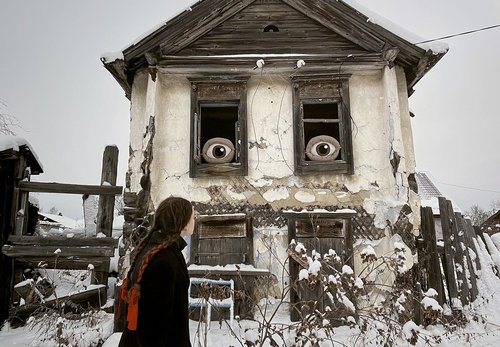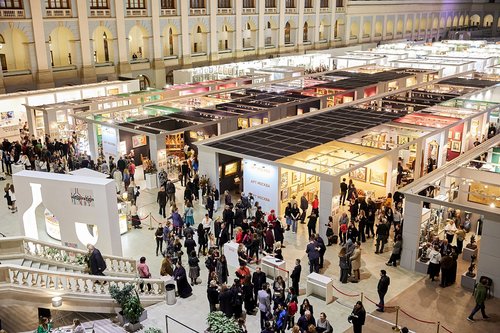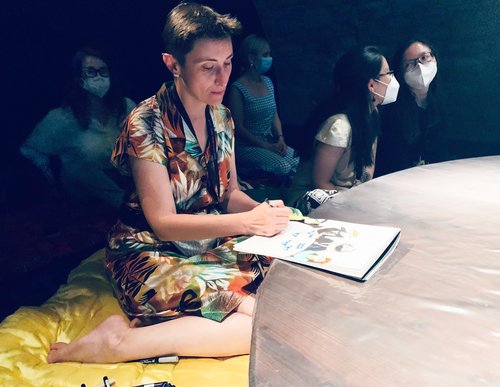Akhmetgalieva’s Fusion of Digital and Analogue Art

Portrait of Tanya Akhmetgalieva with her work. Photo by Ivan Boiko, courtesy of Marina Gisich Gallery
Tanya Akhmetgalieva’s solo exhibition ‘Electrodream’ at the Marina Gisich Gallery in St Petersburg represents a step away from her signature textile-based works inventively fusing digital and analogue media. Inspired by virtual reality and Philip K. Dick’s sci-fi, her work blurs the boundaries between the real and virtual worlds.
Tanya Akhmetgalieva (b. 1983) is no stranger to innovation. While she graduated from the traditional Textile Art Department at the Stieglitz Academy in St. Petersburg at the same time she also graduated from the experimental School for Young Artists at the Pro Arte Institute. At the end of the 2000s she became one of the first contemporary artists in Russia to embrace embroidery and weaving as a medium. Since her first appearance on the art scene with ‘Red Thread’ in 2008 and the following year ‘The Pupal Stage’, works in which the personal was combined with the political, she has successfully continued to use the archetype of thread, which runs through all her works. She uses the thread in her weavings like lines made in pencil or paint, with organic colours, reserving a much a brighter palette for her video art, like her 2011 ‘Installation Toys’. Gradually over time in projects such as ‘Hello, World!’ (2011–2014) and ‘Allergic to Dust’ (2014), her threads evolved into electric wires, magnetic waves, and internet connections, she recalls “I had started to feel cramped in textiles. I don't want to be confined by anything.”
Her solo show in St Petersburg ‘Electrodream’ continues and develops the themes and images she explored in a solo exhibition in Helsinki in 2019 at Galerie Forsblom called ‘The Poisonous Berries’, in which the artist turned to painting and works on paper. According to Akhmetgalieva, the stories she tells exist as chapters of a novel or TV series: “The world I am making is not contained in one exhibition or one project, it is all part of one big story, in which I tell different things from different angles, from chapter to chapter.”
If the artist deconstructed painting using handmade embroidery techniques, her painting does the same with computer reality, which is the subject of this new project and the source of her new images. In the gallery space, canvases of various sizes and formats are reminiscent of computer and plasma screens, on which a new digital world is simultaneously taking place and being created as if from scratch. The artist paints the basis of her images by hand in white. She is particularly interested in what is man-made, although the sketches are made entirely on the computer, she adds, “It's important that things become uneven, there are errors and nothing is perfect. I'm interested in how a new space generates new ideas.”
The transition from the digital environment in the form of 3D sketches to the analogue one – paintings – undergoes a complex transformation in her work. Transformation is one of the main concepts Akhmetgalieva uses to explain the works in her new series: “The image of the virtual world in these works is formed from my experiments with computer graphics and the way I work with 3D. A lot of things – like stripes– are pulled from that space. Some subjects are born in the digital environment, then they travel into my paintings, and later they can go back there to be transformed again. There is a process of constant change going on all the time like a carousel, an endless spinning back and forth”.
The title ‘Electrodream’ reflects the somnambulic state in which images from different realities are glued together into a new reality, which is pinned down by the artist on the canvas. This project is based on Philip K. Dick's famous novel ‘Do Androids Dream of Electric Sheep?’, better known from the film ‘Blade Runner’, but the artist does not seek to illustrate the novel. The images she transfers to canvasses come from her own imagination: “they roam, they blossom, they change bit by bit”.
It was American writer William Gibson (b. 1948) who first discovered the concept of virtual reality, it was then a figment of pure fantasy as he had very little sense of what computers were and what they could do when he wrote his novel ‘Neuromancer’. Digital space itself has no visible appearance and Hollywood was the first to visualise it in films like the teen movie ‘Hackers’ to ‘The Matrix’, overflowing with operatic pathos where the flow of data was depicted in the form of a colourful vortex or digital columns resembling modern data centres. In Russia, Western mass culture became widespread only in the 1990s, so American science fiction and the entire visual traditions associated with it became familiar to the artist all at once while she was growing up.
Curator of the exhibition, Russian art historian Olesya Turkina calls out the striking images that leap out at us from the paintings: “The jaw of a cat in the mouth of a snake, sparks, a cherry, which became the embodiment of the ultimate absurdity - ‘the cherry on the cake’ – thorns, a wooden swan flying from a carousel, chains as a sign of a lack of freedom and impossibility to break away despite the illusion of flight, discs powered by electric current.” The brightness, vivacity and bold assertiveness of these paintings creates a technological pathos that continues to interest and surprise the artist herself who reflects, “Figures turn into colour and shapes, they move and are transferred to the plane and subjected to another plane and new distortions”.
Turkina sums it up this way: “At first glance, ‘Electrodream’ may appear to be a gamified version of painting, levelling its texture with the comic-strip-style language of the digital age. However, instead of interaction, the paintings are deliberately cold and alienating. It is unclear where the worlds depicted on the canvas are and what is left outside them, where the artist/viewer is and who he or she is. There is a superficial positivity that does not fool anyone. There is a sense of disorientation, of misunderstanding and loss, typical of the transformation experienced when moving from the real world to virtual ones.”
Tanya Akhmetgalieva. Electrodream
St. Petersburg, Russia
6 September – 17 November, 2024






















